More Grower-funded research projects
Plant establishment
Compaction Impacts on Canola Establishment
Principal investigator:
Curtis Cavers, AAFC Portage la Prairie
Funding:
Manitoba Canola Growers
Purpose:
The objective is to determine how to manage canola stands under compacted soils and/or excess moisture conditions for best performance. This study examines the differences in soil strength (compaction) and canola stands under four tillage treatments of varying depths and intensities: vertical tillage; conventional tillage; subsoiled and raised bed/controlled traffic agronomy. Trials are duplicated under two different moisture regimes: dryland (rain-fed) conditions and irrigated to simulate wet (excess) moisture conditions.
Progress:
One trial was set up at an AAFC site at Portage la Prairie, Manitoba, in 2017, with data to be collected and analyzed. Two additional trials will be conducted at the same site in 2018.
To germinate or not to germinate? Towards understanding the role dormancy plays in canola seed vigour, seedling vigour and stand establishment
Lead researcher:
Sally Vail, AAFC Saskatoon
Funding:
Alberta Canola, SaskCanola, Manitoba Canola Growers, AIP
Purpose:
This project is investigating the inter-relatedness of the potential for different forms of dormancy, seed biology characteristics and seedling vigour traits across a diverse panel of Brassica napus lines. It will also investigate the effect of the growing environment for parent seed and source-seed processing on enhancing or diminishing dormancy potential of canola seed. Results from this project will guide plant breeding approaches to ultimately reduce the secondary or inducible dormancy potential of canola.
Progress:
A wide range of secondary dormancy potential has been identified across the diverse panel of lines in seed harvested from multiple contrasting environments. The role environment plays in primary and secondary dormancy potential is shown to affect a subset of lines. There are high- and low-dormancy potential lines that are consistent across parent-seed-growing environments. Seed vigour metrics for lines and seedlots are being explored and preliminary results suggest seed vigour is not associated with secondary dormancy potential. Protein and seed fibre content appear to be moderately associated with dormancy potential and associations with additional seed quality traits continue to be assessed. Characterization of lines for propensity to germinate within the ripening pod is ongoing, and values will be compared to dormancy potential values. We are also working with hybrid-seed production partners to survey secondary dormancy potential within current commercial seedlots.
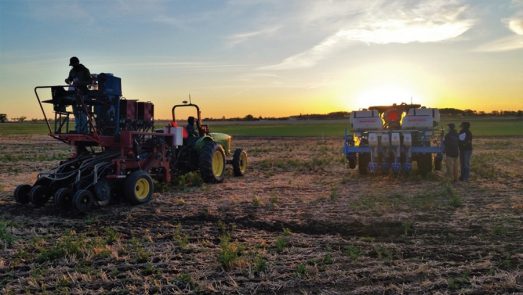
Developing canola agronomy with precision planters
Principal investigator:
Ken Coles, Farming Smarter
Funding:
Alberta Canola, Manitoba Canola Growers, Farming Smarter
Purpose:
Precision planters provide superior depth control and seed distribution over conventional seeders, and thus have the potential to improve the proportion, uniformity and rapidity of canola emergence. This study hopes to explore optimum row spacing and seed-safe rates with in-row liquid phosphorus fertilizer.
Progress:
Four dryland and two irrigated trials were completed in southern Alberta during the 2016 and 2017 growing seasons. Results to date show a significant improvement in emergence using the planters. A yield advantage is clear with the planter on 12-inch row spacing and a slight disadvantage on 20-inch spacing versus the air seeder equipped with Pillar Laser openers. There was no apparent injury associated with seed-placed liquid phosphorus up to 40 kg/ha of P205 where yields maxed out. This would suggest that canola yields are potentially limited by insufficient phosphorus.
Fertility management
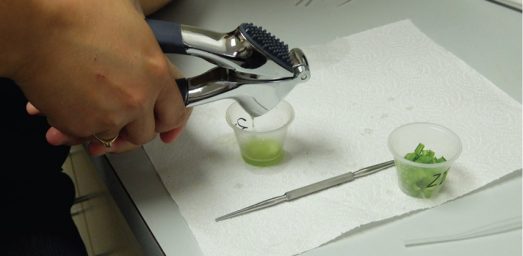
Evaluation of sap nitrate for in-season assessment of crop nitrogen status
Principal investigator:
Dale Tomasiewicz, AAFC Outlook
Funding:
SaskCanola
Purpose:
The project adds sap nitrate analysis to the range of in-season tests to be evaluated for determining canola and wheat N status, enhancing an ADF-funded study of fertigation. Sap analysis can be conducted quickly on-farm, so may be a suitable diagnostic tool for guiding in-season N application decisions for topdressing or fertigation.
Progress:
The first of three field seasons was completed in 2017. Preliminary results showed concentrations of nitrate in the sap (from canola leaf petioles and wheat stem bases) to vary widely with N fertilization treatment. Sensitivity to N treatment effects was much greater at the later sampling stage (late June, a few days prior to stem elongation or heading) than at the earlier stage (mid-June, 5- to 6-leaf stage).
Crop response to foliar-applied phosphorus fertilizers
Principal investigator:
Jeff Schoenau, University of Saskatchewan
Funding:
SaskCanola, ADF, SPG, SWDC
Purpose:
To determine the effect of foliar-applied phosphorus (P) on crop (canola, wheat, pea) response and residual soil phosphorus fertility in comparison to soil-applied phosphorus.
Progress:
The study began in spring of 2016 with four field-research sites selected across the Brown, Dark Brown and Black Soil Zones of Saskatchewan. Different treatments of foliar-applied orthophosphate solution were applied mid-season to canola, wheat and peas. Some treatments were in combination with granular monoammonium phosphate (11-52-0) applied with the seed. Plant samples were obtained for analysis before and after foliar P application. Application of foliar P resulted in significant increase in P concentration measured in plant tissue following application. In 2016, canola grain yield responded positively to seed-row applied 11-52-0 at one site. Overall in 2016, there was no apparent yield benefit from splitting application of P fertilizer between seed-row placed at time of seeding and foliar P at canopy closure for the three crops. Soil residual P levels were unaffected by P form and placement strategy. In controlled environment trials conducted in 2016 and 2017, similar results were obtained. Small-plot field trials were conducted again in 2017 at three sites in southern Saskatchewan. A field-scale trial with a commercial P-containing foliar product was also set up at one site in 2017.
Enhancing canola production with improved phosphorus fertilizer management
Principal investigator:
Stewart Brandt, NARF
Funding:
SaskCanola
Purpose:
This research investigates whether current phosphorus (P) fertilizer recommendations are adequate for high-yielding cultivars and if all fertilizer P needs to be seed placed. It also examines if current recommendations regarding safe rates of P and sulphur (S) are suitable for typical knife or hoe openers in use today.
Progress:
In 2016, trials were conducted at three sites in Saskatchewan (Melfort, Scott and Indian Head). Preliminary results indicated that plant densities were unaffected by side-band P but declined with increasing P rates when seed placed. In addition, placing P with S in the seed row resulted in lower plant densities than when placed alone. At two of three sites, canola yield increased significantly with increasing P fertilizer. At one location, side-band P resulted in significantly higher yield than seed-placed, and tended to do the same at another location. The study was continued at the same three locations in 2017. Results are being compiled as yield data is available and the annual report will be submitted in early 2018.
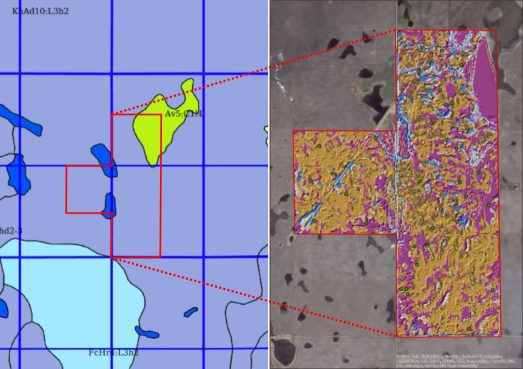
Enhanced Saskatchewan soil data for sustainable land management
Principal investigator:
Angela Bedard-Haughn, University of Saskatchewan
Funding:
SaskCanola, SPG, ADF
Purpose:
This project aims to provide improved access to Saskatchewan soil information, both desktop and mobile. In addition, it will explore ways to enhance and utilize this soil information, including digital soil mapping at a resolution and scale useful for precision management and applications that allow producers to upload and integrate their own field-scale data to inform nutrient-management decisions.
Progress:
The beta version of the new Saskatchewan Soil Information System (SKSIS) has been distributed to a group of field testers from multiple sectors to get their feedback on its format and function. Demonstrations at the Agronomy Research Update and Soils and Crops were met with great enthusiasm. The audience was particularly excited to see drafts of refined soil maps for our test sites, which were developed using an optimized field sampling approach and a drone-collected digital elevation model. In the remaining few months of the project, we are working on finalizing SKSIS for official launch, incorporating any feedback received on the beta version, testing the potential for using the refined soil maps in understanding potential nutrient response across a field, and figuring out the next steps for the project in 2018 and beyond. An application has been submitted for an additional two years of funding to further enhance the site’s functionality.
Impact of source and placement of nitrogen and sulphur fertilizers on canola
Principal investigator:
Ramona Mohr, AAFC Brandon
Funding:
SaskCanola
Purpose:
Increasing farm size in western Canada has led some farmers to move back to less efficient broadcast nitrogen application in an effort to hasten spring seeding operations, thereby increasing the potential for the gaseous loss of nitrogen via volatilization. This study aims to identify fertilizer management practices that reduce the potential for volatilization losses, and improve fertilizer nitrogen use efficiency for canola.
Progress:
In 2017, field experiments were established on a calcareous and a non-calcareous soil near Brandon,Manitoba to assess the effect of various liquid and granular fertilizers, surface-applied or banded, on early-season N volatilization losses, crop yield and quality, and nutrient-use efficiency in canola. Fertilizer sources include urea, ammonium sulphate, UAN (with and without Agrotain or ATS), SuperU and urea impregnated with ammonium sulphate. Sample processing and analysis is underway currently.
Identifying the mechanisms responsible for greater-than-expected residue-induced N2O emissions from canola and flax
Principal investigator:
Richard Farrell, University of Saskatchewan
Funding:
SaskCanola, ADF
Purpose:
Previous research found a higher potential for nitrous oxide (N2O) emissions from decomposing canola (and flax) residues compared to wheat or pea residues. This project aims to identify the reasons for this and provide guidance for future studies to develop and test strategies to minimize N2O emissions from oilseed residues and retain more residue-derived N in the soil for subsequent crop growth.
Progress:
Biochemical and isotopic characterization of the nitrogen-15 and carbon-13 labeled crop residues has been completed and soil microcosm studies with the residues are currently underway. These studies will allow us to determine whether N2O emissions are influenced primarily by the physical or biochemical characteristics of the residues.
Integrated pest management
Design and testing an in-field real-time nano-sensor device for pathogen monitoring in canola
Principal investigator:
Xiujie Li, InnoTech Alberta
Funding:
Alberta Canola, ACIDF, InnoTech
Purpose:
The long-term goal is to develop an in-field sensor for the detection of plant disease pathogen levels and transfer results to an electronic device in a real-time fashion. The purpose of this project is to design and make the device, and test it in the greenhouse and in the field.
Progress:
Signal transmission from the nano-biosensor to an electronic device has been achieved. The researchers are currently working on the modification of the nano-biosensor chip to improve the sensitivity to detect low level of Sclerotinia sclerotiorum spores.
Improving sclerotinia disease control in edible beans and canola
Principal investigator:
Michael Harding, AF
Funding:
Alberta Canola, WGRF, APG
Purpose:
The objectives were to look for synergistic relationships between foliar-applied micronutrients and fungicides when tank mixed, and to evaluate the efficacies of “resistance-priming” chemicals as seed treatments to improve sclerotinia management.
Progress:
The final report is in preparation. Synergistic combinations of trace elements and fungicides were determined in laboratory experiments using biofilm approach. Phase 1 involved screening for synergies between combinations of foliar-applied trace elements (Ag, B, Ca, Cu, Mn, Zn) and currently registered fungicides (boscalid, fluazinam, penthiopyrad, picoxystrobin, ciprodinil, fludioxonil). This screening used a novel, high-throughput biofilm reactor and standard method (ASTM E2799-11) to test 324 treatment combinations and identify the top 10 candidates for field testing. Phase 2 involved field testing of the top 10 most effective combinations. Two of the fungicides (fluazinam and cyprodinil) were very responsive to the addition of at least one of the trace elements tested. The results demonstrated that trace elements such as CuSO4, AgNO3 and ZnSO4 can improve the efficacy of some fungicides versus S. sclerotiorum biofilms. The top-performing combinations were then tested in the field. In the replicated, small-plot field studies a few synergistic combinations appeared in some years, however none of the tank-mixed treatments were consistent in all years tested. One of the resistance-priming chemicals applied to seed has shown significant white mould reduction in three of eight years and significantly higher yields in five of eight years in dry bean. Unfortunately, the effect was not significant against stem rot in canola.
Monitoring the race dynamics of Leptosphaeria maculans for effective deployment and rotation of resistance genes for sustainable management of blackleg of canola in Western Canada
Principal investigator:
Gary Peng, AAFC Saskatoon
Funding:
Alberta Canola, SaskCanola, Manitoba Canola Growers
Purpose:
Cultivar resistance plus extended crop rotation is the key to blackleg management. The deployment of effective resistance (R) genes in canola breeding depends on the knowledge of avirulence (Avr) genes in the pathogen population. This project will continue monitoring the blackleg pathogen population on the Prairies using diseased samples from a large number of commercial canola fields. The information will be useful to blackleg resistance breeding by deploying R-genes effective against the pathogen population and to the selection of canola cultivars carrying effective R-genes over canola crop regions.
Progress:
Field collection of blackleg samples has been completed for the 2017 crop year, with the help from provincial canola disease survey program coordinators. These samples are being processed and will be tested for the Avr profile shortly.
Characterization of the new strains of the clubroot pathogen in Alberta
Principal investigators:
Sheau-Fang Hwang, AF, Stephen Strelkov, University of Alberta
Funding:
Alberta Canola, SaskCanola, ACIDF, WGRF
Purpose:
Objectives are to monitor the spread of novel clubroot strains through surveys, assess the potential of novel pathotypes to reappear, characterize the pathotypes of clubroot that appear where resistance has broken down and multiply inoculum of novel pathotype(s) for resistance screening.
Progress:
In 2016, a survey of 570 commercial canola crops representing 40 counties and municipalities in Alberta revealed 68 new fields infested with clubroot. Another 221 new cases of the disease were found during surveillance by municipal and county personnel, for a total of 289 new clubroot-infested fields in 2016. Clubroot infestations have been confirmed in a grand total of 2,443 fields in Alberta since surveys for this disease commenced in 2003. All of the pathotype testing of the 2016 populations is now complete. In total, strains of P. brassicae capable of overcoming resistance were confirmed in 22 new fields (64 fields in total since 2013). Surveys have identified a total of 19 known pathotypes in Canada, 14 of which can break resistance in CR canola (and five of which are the original “old” ones).
Toward a strategy for reducing the spore density and dissemination of clubroot of canola in Alberta
Principal investigator:
Sheau-Fang Hwang, AF
Funding:
Alberta Canola, ACIDF, WGRF
Purpose:
The aim is to develop a better understanding of the distribution and dispersal of clubroot and to develop methods to eradicate or reduce newly established infestations within fields and on a regional basis.
Progress:
Experiments were conducted to evaluate the effect of metam sodium (Vapam) fumigant and application methods – including watering, soil surface covering and soil incorporation – on clubroot of canola. At higher rates (0.4-1.6 mL per litre of soil), metam sodium increased canola seedling emergence and plant health, and reduced root hair infection, gall weight and clubroot severity under greenhouse conditions. Metam sodium application improved subsequent plant growth and reduced clubroot severity, but land preparation and volume of water applied did not affect efficacy. The incorporation of metam sodium into the soil and plastic covering after application improved fumigant efficacy. The study showed that soil fumigation with metam sodium can reduce clubroot severity and improve plant health in the subsequent canola crop. Clubroot infestations generally start with a few isolated plants, often close to the field entrance. Fumigation may have a role in the eradication of isolated areas of infestation, especially where the pathogen is not already endemic.
Find all previous Science Editions online at canoladigest.ca
and more on research discoveries at canolaresearch.ca.
Supporting continued development of clubroot-resistant canola and early detection of clubroot outbreaks
Principal investigator:
Michael Harding, AF
Funding:
Alberta Canola, WGRF, ACIDF
Purpose:
The objectives were to evaluate canola lines and cultivars for their various levels of resistance to P. brassicae (pathotype 5) and evaluate the efficacy of soil amendments and treatments for clubroot management. Additionally, the project enhanced clubroot surveillance in southern Alberta to rapidly identify any new introductions or outbreaks of clubroot south of Highway 1. The project also provided a backdrop and demonstrations for clubroot extension field days.
Progress:
The final report is in preparation. Since 2013, dozens of new canola lines were screened for clubroot resistance at this disease nursery and a number of them have shown strong resistance to pathotype 5. Soil amendments and chemical fumigants have demonstrated limited ability to provide significant or consistent control of clubroot in areas with high resting-spore populations. Clubroot surveillance has not discovered any new infestations south of Highway 1, however three new infestations just north of Highway 1 were recently reported. Clubroot field days drew 70-100 participants each year they were held.
Genome-wide functional analysis of Plasmodiophora brassicae effectors and the management of clubroot disease
Principal investigators:
Peta Bonham-Smith, Christopher Todd, Yangdou Wei, University of Saskatchewan
Funding:
SaskCanola, ADF
Purpose:
The objectives are to identify the P. brassicae proteins (effectors) and their host targets. Understanding these plant-pathogen protein interactions will provide the tools to unmask the pathogen within the cell, thereby allowing the plant defence system to fight the pathogen and control the clubroot disease. Identified P. brassicae effector proteins will be used as markers to track different P. brassicae pathotype populations in Prairie fields.
Progress:
This is a new study, but to date, six possible effector proteins have been identified that interfere with the plant defence system. Identification of more effector proteins is in progress, along with the identification of the plant proteins with which the effector proteins are interacting. Molecular and cellular mechanisms underlying P. brassicae effector activities and host responses are currently under investigation.
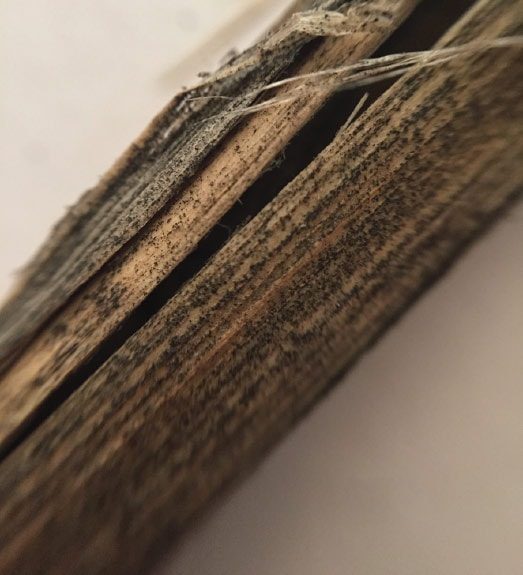
Verticillium longisporum in Manitoba: Understanding the pathogen and establishing surveillance capacity
Principal investigator:
Mario Tenuta, University of Manitoba
Funding:
Manitoba Canola Growers, Richardson International, MB Grain Hub, GF2 and WGRF
Purpose:
In 2014, Verticillium longisporum, a fungal wilt pathogen of crucifers, was identified on canola in a field in Manitoba. The pathogen is one of the most important diseases of rapeseed in Europe, but little is known about the pathogen and its behaviour in Manitoba or the Prairies. This project will study the distribution and ability of the pathogen to disperse to soils on the finding farm, identify the hybrid line of the pathogen present and establish real-time PCR quantification protocols for the pathogen in soil. This prepares the province and industry for self-directed management of the pathogen.
Progress:
An M.Sc. student, Abhishek Agarwal, has a detailed survey of V. longisporum from fields at the farm where the pathogen was first identified. The pathogen is widespread on the farm, and while the vast majority of fields have low concentrations, a few fields have very high concentrations. This suggests the pathogen can move around fairly easily. The hybrid line found at the farm is that which is believed most aggressive to rapeseed. Preliminary analysis has not shown cropping history to be a factor in the distribution of the pathogen in the finding farm.
Enhanced modelling of swede midge population dynamics in North America
Principal investigator:
Rebecca Hallett, University of Guelph
Funding:
SaskCanola, Alberta Canola (CARP)
Purpose:
The aim is to develop a complete population dynamics model for swede midge. The model will be used to explore differences among North American
populations of swede midge and will try to predict the lag-time between first detection in an area and subsequent occurrence of economically-damaging populations.
Progress:
MSc student Jenny Liu has evaluated our previous forecasting model, MidgEmerge, to identify weaknesses that need improvement. The model will be re-developed with updated life cycle information in order to predict emergence more accurately. Experiments were undertaken this summer at University of Guelph and at AAFC Saskatoon to determine development and mortality rates of Ontario swede midges (larvae, pupae, adults) at different temperatures. Development rates and survival information will now be incorporated into MidgEmerge to improve its accuracy in predicting adult peaks of swede midge.
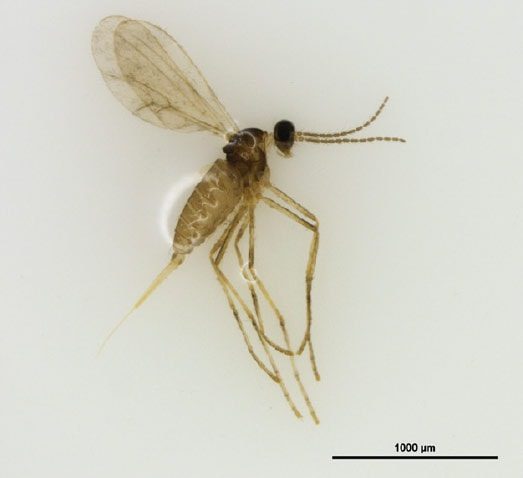
the Prairies.
Assessing the impact of Contarinia sp. on canola production across
the Prairies
Principal investigators:
Meghan Vankosky and Boyd Mori, AAFC Saskatoon
Funding:
SaskCanola, Alberta Canola
Purpose:
A new, undescribed species of Contarinia midge was found attacking canola flowers in 2016. As this is an undescribed species, its life history, development, timing of adult emergence, distribution, and impact on canola crops needs to be determined. The purpose of this project is to conduct field and laboratory research to investigate this potential canola pest.
Progress:
Summer 2017 marked the first year of data collection for this project. The timing of adult midge emergence was monitored using emergence cages in northeastern Saskatchewan and canola plants were dissected weekly during the growing season to determine the timing of midge attack and midge development. To determine the distribution of this insect, a survey of canola fields in Alberta, Saskatchewan and Manitoba was completed in late July/early August. Midge larvae were found in all three provinces, and their identity is being confirmed in the laboratory using morphological and molecular techniques. Preliminary results from the 2017 field season will be made available at upcoming industry and academic meetings.
Development of a pheromone-based monitoring system for a newly identified Contarinia midge on the Canadian prairies
Principal investigators:
Meghan Vankosky and Boyd Mori, AAFC Saskatoon
Funding:
SaskCanola, Alberta Canola
Purpose:
A new species of midge, closely related to swede midge, was recently discovered in canola crops across the Prairies. Swede midge monitoring is facilitated by pheromone traps that are attractive to adult male midges. Pheromone traps help determine the presence or absence of swede midge, and can be used to time insecticide applications. The purpose of this project is to determine if the new midge species produces pheromones that can be used to develop a pheromone-based monitoring system for this potential canola pest.
Progress:
In the first year of this project, midge specimens were collected from canola fields across the Prairies and shipped to our collaborators in the United Kingdom who are working to determine if this species produces pheromones that can be utilized in a pheromone-based monitoring program. Preliminary results suggest female midge produce a pheromone. This compound will be further investigated to determine if it is attractive to male midges and if it can be synthesized for use in pheromone traps.
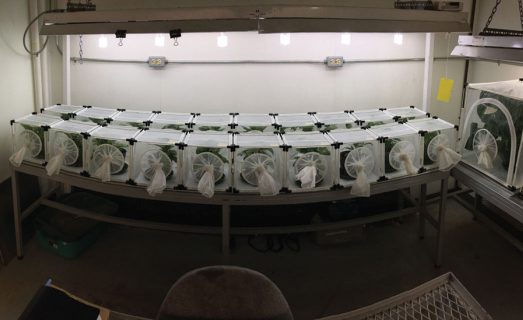
Ecology of swede midge — host plant interactions
Principal investigators:
Boyd Mori, Owen Olfert, Julie Soroka, AAFC Saskatoon
Funding:
SaskCanola, ADF, WGRF
Purpose:
The purpose is to investigate host-plant susceptibility or resistance factors to swede midge, with the ultimate aim of identifying host-plant resistance.
Progress:
After year 2 of 4, researchers have conducted a literature review of potential plant species that could be hosts for swede midge. The plants were ranked by occurrence (extremely common to rare) in Saskatchewan and the Prairie provinces and a list of species to be tested was created. A colony of swede midge has been established at the Saskatoon Research and Development Centre and initial no-choice bioassays have been conducted on seven plant species, with experiments ongoing for a further five species. Initial results indicate that all species of plants tested to date can act as swede midge hosts, but the number of developing larvae varies by plant species. Choice tests and behavioural experiments are being organized for the fall and winter.
Getting more bang for your buzz: does pollination compensate for canola yield loss under sub-optimal moisture, nitrogen fertilization, and/or seeding rate?
Principal investigators:
Ralph Cartar, University of Calgary; Shelley Hoover, AF Lethbridge; Steve Pernal, AAFC Beaverlodge; Neil Harker, AAFC Lacombe; Andony Melathopoulos, Oregon State University
Funding:
Alberta Canola, Beekeepers Commission of Alberta
Purpose:
The study includes three experiments: (1) How dependent on pollinators are different varieties of commodity canola? (2) How does the timing of water stress affect yield in varieties that differ in the strength of their pollinator-dependence? (3) Does seeding density and/or nitrogen fertilization moderate any yield benefits from pollinators?
Progress:
Experiment 1: In the Fall of 2016, using seeds of 23 canola varieties, the research team set up a greenhouse experiment to compare patterns of flowering, nectar production, plant traits, and yield of each variety in the presence and absence of bumble bee pollinators. The data set for this experiment is now complete and being analyzed. Experiment 2: In the Winter of 2017, the team performed another greenhouse experiment on a subset of eight varieties from the first experiment. All were hybrid varieties. This experiment manipulated the timing of water stress (no stress vs vegetative stage vs pod-filling stage) as well as presence of bumble bee pollinators. Data extraction from collected materials is underway. Experiment 3: This field experiment began in the summer of 2017 in Beaverlodge, Alberta. Plants from four different varieties of hybrid canola were grown in and outside of screen tents (see the photo), simulating the presence and absence of pollinators. We recorded plant traits and pollinator visitation during plant development, and harvested plants in September. Data are currently being compiled in the lab. A repeat of this experiment is planned for the summer of 2018.
In April 2017, we welcomed George Adamidis to our research group, who brings an expertise in plant ecology.
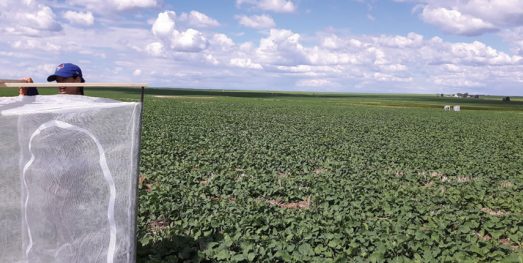
Surveillance networks for beneficial insects: Can natural habitats serve as insect reservoirs, and do they contribute to canola yield?
Principal investigator:
Paul Galpern, University of Calgary
Funding:
SaskCanola, Alberta Canola, Manitoba Canola Growers, CCC
Purpose:
This project will examine the relationship between the diversity and abundance of beneficial insects and canola production in Western Canada. Specifically, it will address the role of natural habitats near canola fields as reservoirs for pollinators and natural enemies of canola pests as well as the capacity of these beneficial insects to increase seed yield through pollination and pest reduction.
Progress:
In 2016, 25,769 bees representing 184 species were collected and identified from 122 locations in southern Alberta. The first meeting of the Prairie Beneficial Insect Working Group took place as scheduled November 7, 2016. For 2017, the goal was to see how the availability of beneficial insects and seed yield change as the distance to natural habitats increases. Sampling targeted pollinators as well as other beneficial insects that are predators of crop pests. Processing and identifying the 75,000 specimens collected this summer is underway.
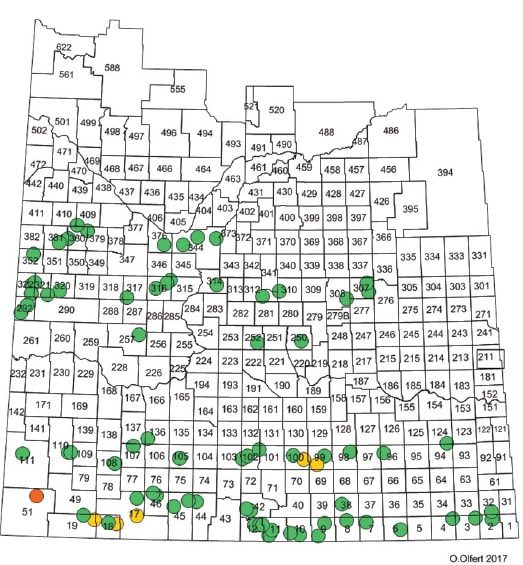
Validation of lygus and other insect-pest thresholds in commercial farms throughout Alberta
Principal investigator:
Hector Carcamo, AAFC Lethbridge
Funding:
Alberta Canola, SaskCanola
Purpose:
The primary objective is to validate lygus thresholds derived from cages in commercial canola fields. Secondary objectives are to assess insecticide sprays for other pests such as flea beetles or cabbage seedpod weevil on canola yield and relate landscape features to lygus distribution.
Progress:
In southern Alberta in 2017, conditions were very dry and hot and some canola fields suffered heat stress. Lygus bugs were low in most Alberta fields but there were sufficient numbers for study in three fields. In all three fields, farmers only sprayed the plots, which were 100 m x 40 m wide. The two treatments (sprayed and not sprayed) were replicated four times and randomly assigned to plots separated by about a 40 m unsprayed buffer. Insects were sampled with a sweep net before and after spray (a week later). Hand samples (two rows by 71 cm) were collected at four locations (2-4 m apart) near the two sampling points where lygus were collected. We also collected 10 main racemes to assess cabbage seedpod weevil damage at the two lygus sampling points. As a side study, plants were collected at the pod stage to count diamondback moth larvae and see if the numbers relate to those from sweeping. In Saskatchewan, five canola fields that spanned the majority of the soil zones were monitored weekly with sweep nets and yellow sticky cards. Several growers were asked to participate in the lygus spray study if lygus numbers in fields reached the economic threshold of two per sweep. Lygus bugs were scarce in the weekly surveyed fields and populations levels were never in danger of reaching the economic thresholds. Canola fields in Rural Municipalities across Saskatchewan were surveyed when the canola was in full bloom as part of the cabbage seedpod weevil survey administered by the Prairie Pest Monitoring Network. Across Saskatchewan, no appreciable populations of Lygus bugs (close to 2 per sweep) developed in any of the surveyed canola fields except for RM 51 which did approach the economic threshold at full bloom. (See the map.) In Manitoba, seven fields were monitored for lygus bugs and numbers were very low.
Assessing the influence of base germination temperature and chemical desiccants on the recruitment biology of cleavers
Principal investigator:
Chris Willenborg, University of Saskatchewan
Funding:
SaskCanola
Purpose:
This project aims to determine the base germination temperature of several cleavers populations in Western Canada and determine the influence of chemical desiccants on cleavers seed properties.
Progress:
Base germination temperature of cleavers was found to be similar (2°C) in all populations except Saskatoon, which was 4°C. This is an important finding as previous research had a large base germination range of 2-20°C (Malik and Vanden Born 1987). Growers can use this information to predict optimal times to provide management. For example, growers may not want to spray or till until the majority of seed has germinated, which in this case would be after the first few weeks of April, in our area. For the pre-harvest desiccants part of the study, data indicate that applications of glyphosate plus saflufenacil results in the lowest amount of cleavers dockage. Glyphosate and saflufenacil applications separately and also tank mixed resulted in cleaver seed that was the least viable and had the most electrolyte leakage. High electrolyte leakage from cleavers seeds is related to the poor physiological nature of each seed and most likely results in low viability. Data from 2017 will help clarify the reason why those applications were most efficacious at reducing cleavers seed viability.
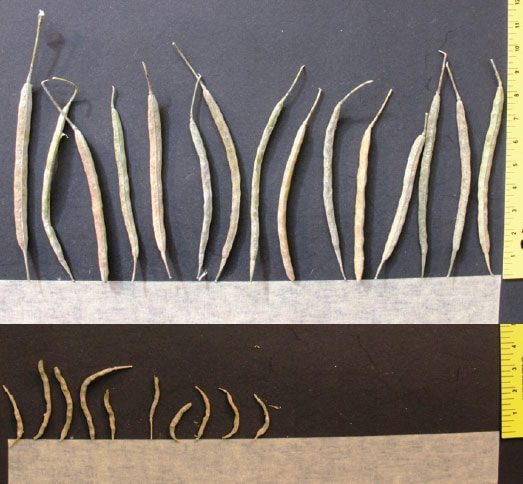
Impact of drought and heat during flowering on canola yield
Principal investigator:
Raju Soolanayakanahally, AAFC Saskatoon
Funding:
SaskCanola, ADF, AAFC
Purpose:
Changing precipitation and temperature patterns will cause significant yield losses if drought and heat waves become more common. The project evaluates spring canola lines for stress response to drought, heat and a combination of the two in greenhouse and field conditions. The study employs physiological approaches to identify donor parents for stress-tolerance breeding. The ultimate aim is to get more yields per drop of water. For this purpose, a set of diverse canola lines was grown in greenhouse under four water supply/temperature combinations during flowering: (1) Irrigated plants under optimal temperature (23°C), (2) Drought under optimal temperature (23°C), (3) Irrigated plants under hot ambient temperature (29°C) and (4) Drought under hot ambient temperature (29°C).
Progress:
Photosynthetic activity (carbon fixation and water loss through stomata), different components of seed yield, oil content and its composition were measured under the four conditions. Preliminary results showed a predominant negative effect of heat which decreased seed yield by more than 85 per cent. This effect was noticed and similar for both irrigated and non-irrigated plants, suggesting a heat effect on floral structures and reproduction process. The number of pods as well as the average number of seeds per pod had significantly decreased when plants were exposed to heat. (See the image). Drought had a significant but lesser effect on seed yield under optimal temperature. Pods and seed number were affected more by combined heat and drought exposure than by exposure to a single stressor, showing a cumulative effect. Oil yield decreased remarkably with heat and to a lesser extent with drought, following the same pattern as seed yield.
Integrated approach for flea beetle control – Economic thresholds, prediction models, landscape effects and natural enemies
Principal investigator:
Alejandro Costamagna, University of Manitoba
Funding:
Alberta Canola, SaskCanola, Manitoba Canola Growers
Purpose:
Major objectives of the project are to validate the current nominal threshold for flea beetles in canola, determine natural enemies impacting flea beetle populations, identify landscape features promoting effective natural enemies, and develop models for flea beetle populations based on weather and crop variables to provide timely prediction of the flea beetle population.
Progress:
Researchers conducted 40 trials to determine economic threshold of flea beetles, and 78 grower fields were sampled for flea beetle and its natural enemy populations. In these fields, landscape maps were drawn for 2-3 km area from a focal point. In these studies, they assessed canola phenology, defoliation by flea beetles and abundances of flea beetles and natural enemies. Molecular gut-content analysis of field-collected predator species was done to see which predators fed on flea beetles. Processing of 2017 samples and analysis of data from previous years is underway.
Toxicopathological determination of safe dose ranges of neonicotinoids for honey bee colonies
Principal investigator:
Elemir Simko, Western College of Veterinary Medicine, University of Saskatchewan
Funding:
SaskCanola, WGRF, ADF, MITACS, Saskatchewan Beekeepers Development Commission, Canadian Honey Council, North American Pollinator Protection Campaign
Purpose:
The ‘gold standard’ mammalian safety toxicopathological tests are very sensitive and veterinary pathologists use them to detect sublethal toxic effects of candidate drugs, pesticides and other chemicals in laboratory animals in order to determine the safe dose range. Comparable approaches have not been developed for honey bees. WCVM has the expertise and research capacity to adopt this mammalian ‘gold standard’ safety evaluation to honey bees and to determine the safe dose range for the three most commonly used neonicotinoids in agriculture.
Progress:
Adaptation of mammalian safety histopathology tests to honey bees has begun. Researchers assembled databases of normal histology of the brain of worker bees and the reproductive tracts of drones and queens. Individual larvae and pupae of workers, drones, and queens were exposed to incremental doses of neonicotinoids during the summer 2017 and histopathological evaluation of the effects is in progress. We also performed a large chronic comparative toxicity study and determined that high environmentally realistic doses of neonicotinoids affect colony size and honey collection, whereas there was no effect detected in colonies exposed to medium environmental doses of neonicotinoids.
Development and implementation of a weather-based, near real-time, crop insect pest monitoring/prediction model and program for Alberta
Principal investigator:
Daniel Itenfisu, AF
Funding:
Alberta Canola, AF
Purpose:
The aim is to develop and implement a provincial weather-based near real-time (NRT) insect pest prediction model as a web-based risk management tool for three significant insect pests: bertha armyworm, alfalfa weevil and wheat midge. Considering significant interest from producers on flea beetle dynamics and prediction, we expanded our project to include striped flea beetle and crucifer flea beetle. The models will assist in timely and informed decision making for effective pest management.
Progress:
The project was extended for a year with funding to collect additional field data on wheat midge, alfalfa weevil and canola flea beetles. Phenology and life history of the three pests and their natural enemies along with crop phenology were monitored across 17 sites in Alberta. Weather monitoring occurred at all sites. Spring soil sampling, yellow-sticky trap monitoring and wheat head dissections were conducted for wheat midge. Alfalfa weevil adults and larval populations were monitored in forage and seed crops. Canola flea beetles were monitored using yellow-sticky traps from seeding to pod maturity at seven sites. Weekly weather-based prediction maps were produced for each species. Field data quality control and data analyses across sites and years leading to improved phenology models for each species is underway.
Coordinated surveillance, forecasting and risk warning systems for field crop insect pests of the Prairie ecosystem
Principal investigator:
Owen Olfert, AAFC Saskatoon
Funding:
Alberta Canola, SaskCanola, Manitoba Canola Growers, WGRF, SPG, AWC
Purpose:
The aim is to develop and implement insect surveillance programs to identify risks to crop production from pest species and to highlight and conserve their natural enemies.
Progress:
This project is currently in Year 4 of 5. Surveys were conducted for key field-crop pests, including grasshoppers, wheat midge, cabbage seedpod weevil, bertha armyworm and pea leaf weevil, with data collected from more than 6,000 sites in Alberta, Saskatchewan and Manitoba. Sentinel sites were monitored for flea beetles, cutworms, swede midge and cereal leaf beetle. Regional forecast and distribution maps for the insects monitored will be made available in early 2018 (some provincial maps are already available). The 2017 survey saw an increase in the area surveyed in Saskatchewan and Alberta for some pests, including pea leaf weevil and cabbage seedpod weevil. The project team produced 17 Weekly Updates in 2017 (available online using the Prairie Pest Monitoring Network blog: http://prairiepestmonitoring.blogspot.ca/)
Harvest Management
Pre-harvest herbicide and desiccation options for straight-combining canola: Effects on plant and seed dry-down, yield and seed quality
Principal Investigator:
Chris Holzapfel, Indian Head Agricultural Research Foundation
Funding:
SaskCanola, Manitoba Canola Growers
Purpose:
This project was initiated in 2017 to evaluate potential pre-harvest herbicide and desiccant options and their effects on crop and seed dry-down and seed quality when straight-combining canola. The project is intended to provide guidelines regarding potential benefits of pre-harvest herbicide or desiccant applications when straight-combining canola and make product recommendations tailored to specific needs and expectations.
Progress:
The first year of field trials had locations at Indian Head, Melfort and Scott, Saskatchewan and Melita, Manitoba. Trials included pod-shatter resistant Roundup Ready and Liberty Link canola varieties treated with either glyphosate alone (Liberty Link only), saflufenacil alone, glyphosate plus saflufenacil, diquat or glufosinate ammonium (Roundup Ready only). Trials also had untreated checks. The major dependant variables of interest are visual ratings of stem dry-down, seed moisture at time of harvest, whole plant moisture at time of harvest, seed size and percent green seed. The project will run for three growing seasons.
Genetics
Mapping and Introgression of the highly effective Brassica rapa blackleg resistance gene Rlm11 into spring-type Brassica napus
Principal investigator:
Hossein Borhan, AAFC Saskatoon
Funding:
ADF, SaskCanola and WGRF
Purpose:
Blackleg disease of canola is a persistent threat to canola production in Canada and most other canola-producing countries. Using canola varieties with resistance (R) genes against blackleg pathogen is the most effective way to control blackleg. R-genes work by recognizing matching target genes in the pathogen, termed avirulence (Avr/avr) genes. For a canola R-gene to be effective, it is best if the R-gene recognizes an Avr gene that is present in the majority of blackleg isolates found in a canola field. An example of such an R-gene is Rlm11 that recognises an Avr gene named AvrLm11 in the blackleg pathogen. Our recent survey shows that AvrLm11 is present in 95 per cent of blackleg field isolates in western Canada. We are conducting a research project to determine the location of Rlm11 and help breeders to move Rlm11 into commercial canola cultivars. A canola cultivar with the Rlm11 gene will be effective in preventing blackleg infection in canola farms across the Prairies.
Progress:
This is a new project without much to report at this time.
Developing canola germplasm with diverse mechanisms to enhance the durability of clubroot resistance
Principal investigator:
Gary Peng, AAFC Saskatoon
Funding:
SaskCanola, WGRF
Purpose:
The main objective is to identify and characterize clubroot resistance against a new group of clubroot, pathotype 5x, found in Alberta and virulent towards all current clubroot-resistant (CR) canola cultivars in Canada. Over the years, we identified a large number of CR sources or genes against common pathotype 3 other pathotypes found in Alberta, but the resistance to this new pathotype group is unknown. This project will assess these materials plus additional CR candidates, and identify promising CR genes or gene combinations against 5x.
Progress:
The initial work found several potential candidates against a mixed population of 5x pathotypes. Further work was carried out by introgression of selected CR genes into the background of Brassica napus, and in some cases pyramiding them into breeding lines for development of multiple CR-gene hybrids. Selected genes or gene combinations were assessed using specific 5x populations that showed different virulence (or aggressiveness) toward resistant canola cultivars. This provided a better understanding of resistance differentiation against different 5x populations. Molecular CR mechanisms are being studied for single and multiple CR genes to develop canola germplasm with different modes of action for clubroot resistance.
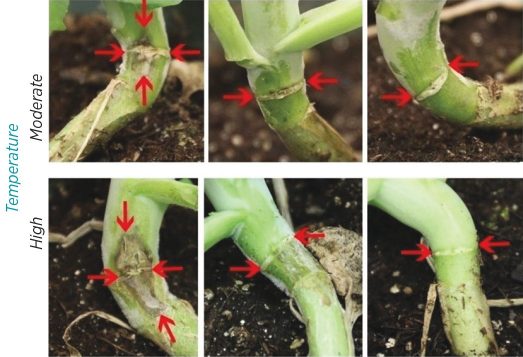
Understanding the mechanisms for race-specific and non-specific resistance for effective use of cultivar resistance against blackleg of canola in Western Canada
Principal investigator:
Gary Peng, AAFC Saskatoon
Funding:
Alberta Canola, SaskCanola, Manitoba Canola Growers, ASP (GF2)
Purpose:
This study aims to characterize blackleg resistance used in Western Canada, and assess potential influence of environmental factors, especially hot, dry conditions, on the expression of resistance to better understand the mechanisms of different types of resistance.
Progress:
Race non-specific resistance was assessed with eight selected commercial canola cultivars from four major seed companies. These cultivars carry only the R-genes Rlm1 and/or Rlm3. Three of the cultivars with slightly different levels of resistance on cotyledons were assessed further using cotyledon and petiole inoculation. Results showed that the spread of pathogen into the stem was more limited on commercial cultivars than on Westar and the infection developed more slowly in the stem of commercial cultivars. It appears that many Canadian commercial cultivars carry non-specific blackleg resistance, while the common R-genes Rlm1 and Rlm3 are no longer effective in most regions of western Canada. Analysis has been conducted with three selected R-genes and three commercial varieties with quantitative resistance (QR) to differentiate molecular mechanisms of blackleg resistance. Preliminary data analysis has identified unique modes of action, especially between major genes and QR. Once completed, the information can aid in resistance deployment strategies for blackleg management. Additionally, these QR varieties were also assessed under a heat-wave temperature condition (32ºC) for blackleg/stem canker resistance performances because high temperatures have been suspected to reduce the effectiveness of QR. Early results have shown that the QR gene(s) in common canola varieties are not affected by high temperatures around the rosette or early flowering stages of canola.
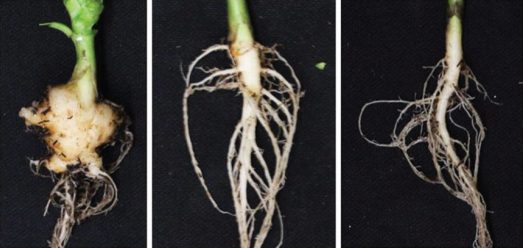
Enhancing the durability of clubroot resistance with multiple resistance genes
Principal investigators:
Tao Song and Gary Peng, AAFC Saskatoon
Funding:
SaskCanola, WGRF
Purpose:
For optimal deployment of new clubroot-resistant (CR) genes, this study hopes to assess whether the better method is to pyramid them into a single hybrid or rotate among CR genes. Researchers also want to know whether longer crop rotations, which help reduce pathogen inoculum in the soil, can benefit resistance durability when multiple CR genes are used. The aim is also to identify potential downsides, if any, for using CR genes under low pathogen pressure background such as most fields in Saskatchewan and Manitoba.
Progress:
Initially, the work has been focused on the assessment of 19 single- and multi-gene hybrids against different populations of the pathotype 5x identified in Alberta. There is differentiation of resistance depending on the population, but two of the multi-gene combinations seemed to provide substantial resistance relative to the control 45H29. Further studies looked at repeated exposure of partially resistant single- and double-gene hybrids against a 5x population and a highly resistant single-gene hybrid against a low level of pathotype 3 population. The initial results (after three cycles of exposure) showed little change in disease severity, indicating the virulence of the pathogen (or pathotypes) might not have changed substantially. Additionally, transcriptome analysis (for RNA sequencing) has been used to understand the molecular mechanisms of double-gene hybrids in resisting multiple pathotypes of clubroot, including 5x vs. the single-gene hybrid susceptible to 5x. The information will assist the development of CR-gene deployment for maximum durability of clubroot resistance.
Developing near-isogenic Brassica napus lines for differentiating pathotypes
of Plasmodiophora brassicae
Principal investigator:
Fengqun Yu, AAFC Saskatoon
Funding:
WGRF, ADF and SaskCanola
Purpose:
This project aims to develop B. napus lines each with a single unique clubroot resistance gene from Brassica vegetable species. These lines could be used for differentiating pathotypes of P. brassicae and rapid incorporation into canola variety development programs.
Progress:
This project is wrapping up and researchers have obtained doubled-haploid B. napus plants containing eight single clubroot-resistance genes.
Identification and genetic mapping of Brassica napus for resistance to pathotype 5x of Plasmodiophora brassicae
Principal investigator:
Fengqun Yu, AAFC Saskatoon
Funding:
SaskCanola, Alberta Canola, Manitoba Canola Growers, ASP (GF2)
Purpose:
The project aims to identify new sources of B. napus for resistance to pathotype 5x, map clubroot resistance (CR) genes and develop markers tightly linked to the genes for use in marker-assisted breeding. It will then work to facilitate the rapid incorporation of multiple CR genes into elite canola breeding lines.
Progress:
More than 300 genetic markers were identified through genotyping by sequencing of 189 Brassica napus accessions. Fifty markers were associated with resistance to pathotype 5x. B. napus lines resistant to pathotypes 3A, 2B and 3D were also identified.
Introgression of disease resistance from Brassica nigra into canola using new-type Brassica napus
Principal investigator:
Fengqun Yu, AAFC Saskatoon
Funding:
SaskCanola, ADF
Purpose:
The project aims to identify clubroot resistance and blackleg resistance genes in B. nigra and transfer the genes into canola.
Progress:
Researchers have genetically mapped a clubroot resistance gene in B. nigra and obtained BC2 progenies from interspecific crosses between B. napus and the B. nigra line. Both clubroot and blackleg resistances in the BC2 populations have been confirmed.
Field evaluation of a valuable germplasm resource designed to dissect complex traits in Brassica napus (the Nested Association Mapping population)
Principal investigator:
Sally Vail, AAFC Saskatoon
Funding:
SaskCanola, Manitoba Canola Growers, Alberta Canola
Purpose:
Considerable resources have been invested over the past four years to develop the spring Brassica napus Nested Association Mapping (NAM) population. This is now completed with over 2,500 recombinant inbred lines (RILs) which represent recombination of 50 diverse founder lines with a reference line. The population structure was designed to decipher complex traits that are often controlled by many genes and interacting biochemical pathways. Continued support for the NAM project facilitates building of an industry-wide resource which has the potential to benefit the entire canola value chain.
Progress:
In the 2017 field season, the diverse founder lines were assessed in Manitoba and Alberta trials and a subset of the RILs alongside the founder lines were tested in Saskatchewan. Trials were leveraged by various collaborators studying seed quality and physiological traits as well as digital plant phenotyping technologies. In collaboration with NAM industry consortium partners, bulking up of RIL seed quantities will be initiated with seed production in greenhouses in anticipation of further increasing lines in the future.
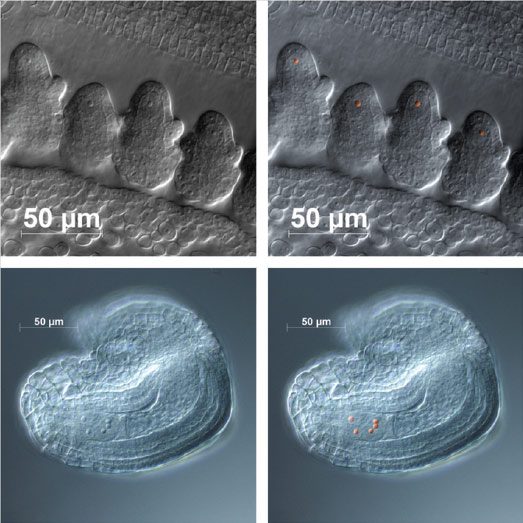
Comparative genomics of apomictic plants: advancing novel tools for niche breeding
Principal investigator:
Tim Sharbel, Global Institute for Food Security
Funding:
SaskCanola, ADF
Purpose:
The aim is to generate a high-quality genome of Boechera, a wild Brassicaceae that can reproduce apomictically. Apomictic plants produce seeds without pollen (male) fertilization, and thus all offspring are genetic clones of the mother. The ability to introduce apomixis into canola would enable single-generation hybrids to be produced and fixed genetically, regardless of the genetic complexity behind the phenotypic traits of interest. This could provide the opportunity to produce more genetically variable canola lines with ease, thereby enabling breeders to exploit niche breeding and rapidly breed varieties adapted to changing environmental conditions.
Progress:
A draft genome of Boechera has been produced, and a high-quality annotation is underway, looking for the genetic triggers for apomixis. Ovules have been microdissected at specific developmental stages for five out of six genotypes for which additional lower-coverage genomes are underway.





